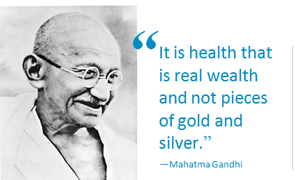
Dear Members:
Last month I asked for prayers for my son-in-law, Deb's husband, Mark, who is very ill. The outpouring of prayers and support from our members has been phenomenal. Prayers are coming in from all over the U.S. as well as Europe, Asia, and Australia.
One of our members is pastor of a large church in the Midwest. He has 93,000 followers on Twitter, many of whom are now sending prayers.
Deb, Mark, and I want to express our heartfelt thanks to all of you for your kindnesses. Please keep the prayers coming"we truly believe in the healing power of prayer.

There are many new developments in the prostate cancer and proton therapy world: New studies show the negative effects of standard prostate cancer treatments on quality of life; new tools are emerging for better diagnosing and staging prostate cancer; doctors and nutritionists are learning more about how the foods we eat impact our immune system and either stimulate cancers or restrict the growth of cancers and other diseases; and drug discoveries are prolonging lives.
Members tell us they are learning a lot from the information presented in the Health section of the BOB Tales. We continue to research and present new and helpful information on topics related to preventing disease, preventing a cancer recurrence, and improving overall health. Many members have changed their diets and lifestyles and are reaping the rewards by losing weight, feeling less fatigued, and enjoying better health.
We have expanded our Odds & Ends BOB Tales section, as many have told us how much they enjoy the features presented there. The humor, riddles, and brain teasers always stimulate members' interest, with hundreds of responses and a lot of feedback each month.
As always, we welcome your feedback and suggestions for improving the BOB Tales. Just sent an email to Deb Hickey at [email protected].
Bob Marckini
To print the BOB Tales newsletter or view the newsletter with a larger font size, click here for the PDF file.
in this issue
- Side effects from conventional treatments"one more reason to choose proton
- Two important tools"PSA Density and PSA Velocity
- Dietary links to prostate cancer
- Drug combination boosts advanced prostate cancer survival
- Dogs sniff out prostate cancer
- 81-year-old back playing team basketball one month after proton treatment
- Funding the future of proton"a special message from Bob Marckini about planned giving
- A spouse honors her deceased husband through a gift to LLUMC
- BOB reunion"Boise, Idaho
- New series"top 20 most common health questions "and answers"
- Much more …
membership: 7,090

We added 78 new members last month. We have members from all US states and 35 countries representing all operating proton centers in the U.S. as well as three proton centers in Europe and Asia.
news report
'Prostate Cancer Treatment Incurs Long-Term Adverse Effects'"One More Reason to Choose Proton
Renal and Urology News posted an article last month titled Prostate Cancer Treatment Incurs Long-Term Adverse Effects. The article was about a Swedish study that was reported at the 2014 American Urological Association "AUA" annual meeting.
The study followed 3,933 men who underwent radical prostatectomy and a control group of 459 men who were cancer-free. The median follow-up was 11.8 years.
Erectile dysfunction was reported by 84 percent of the men who had surgery! Urinary leakage was reported by 23 percent, and 13 percent reported bowel disturbances. There was a 5.5-fold increase in urinary incontinence vs. the control group.
Men who had conventional X-ray radiation, according to the report, had a 75 percent increased risk of urinary urgency and a 5-fold increased risk of bowel dysfunction.
Compare that with this year's NAPT survey results of close to 4,000 former proton patients where:
- 98 percent reported their proton experience was excellent "88 percent" or good "10 percent"
- 98 percent believed they made the best treatment decision for themselves
- 96 percent were satisfied "15 percent" or extremely satisfied "81 percent" with their proton treatment
- 85 percent reported their quality of life was better than "27 percent" or same as "58 percent" before treatment
- 97 percent of those who received proton only reported they were disease free
Most significantly, according to both the 2013 and 2014 proton therapy surveys, there was no significant difference in urinary incontinence, bowel function, and sexual function between men treated with proton-only and the control group of healthy men never treated for prostate cancer … Just one more reason to choose proton, in our opinion.
What We Can Learn from
PSA Density and PSA Velocity
Johns Hopkins University posted an article on this subject in the May edition of their Prostate Disorders Health Alert.
Doctors are continually searching for improvements in techniques for diagnosing prostate cancer. PSA outside the "normal" range used to be the criteria that led to a biopsy, but that has proven to produce many false alarms as well as mis-diagnoses of cancers that were present when PSA was within the normal range.
PSA Density
PSA density takes into account the size of a man's prostate. It's quite simple, and is calculated by dividing the PSA value by the size of the prostate as determined by a transrectal ultrasound. As men age, their prostates typically enlarge, so their "normal" PSA can increase as well.
The higher the PSA density, the greater the chance of cancer because the elevated PSA level is less likely to be caused by prostate enlargement from BPH "Benign Prostatic Hyperplasia". Studies have shown that a PSA density greater than 0.15 may correspond to a higher risk of prostate cancer. This measurement is most useful with men whose PSA is in the 4 to 10 ng/mL range. Here are two examples:
- If PSA is 7.5 and prostate size is 80 cc, the ratio, or density is 7.5 ÷ 80 or 0.09, far below 0.15, indicating a low probability of prostate cancer.
- If PSA is 5.0 and prostate size is 25 cc, the density is 5 ÷ 25 or 0.2, indicating a higher risk of prostate cancer.
This is certainly not a diagnostic test. It's just another tool to use in helping to determine whether or not to move forward with a biopsy.

PSA Velocity
PSA Velocity takes into account the rate of change in PSA. As men age, a growing prostate will produce higher amounts of PSA. A study at Johns Hopkins National Institute on Aging found that an annual increase in PSA of more than 0.75 ng/mL was an early predictor of prostate cancer.
In a study reported in the New England Journal of Medicine, a rapid rise in PSA level "more than 2 ng/mL" in one year predicted a more aggressive cancer.
Another study at Johns Hopkins on PSA velocity, which was published in the Journal of the National Cancer Institute, reported that a man's PSA velocity 10 to 15 years before diagnosis predicted his survival from the disease 25 years later. In this study, men with an early PSA velocity of less than 0.35/year had survived, compared with 54 percent of men whose PSA velocity was greater than 0.35.
Dietary Links to Prostate Cancer
On May 21, 2014, at the 109th Annual Scientific Meeting of the American Urological Association, three studies were presented.
- Men who eat lots of high complex carbohydrate foods "fiber, whole grains" are at reduced risk for prostate cancer. Other studies show that diets rich in sugar-added foods and drinks are associated with increased prostate cancer risk.
- High milk intake was associated with increased risk for rapidly progressive advanced prostate cancer. Yogurt, ice cream and cheese consumption were not associated with either advanced or localized cancer.
- Having two or more metabolic syndrome component conditions was associated with an increased risk of high-grade prostate cancer "obesity, high blood pressure, elevated fasting blood sugar "100", high fasting insulin "5", low HDL "good" cholesterol "<40", high triglycerides "150", or fatty liver"storing fat primarily in the belly.
Current research links increased risk for prostate cancer with everything that raises blood sugar levels: metabolic syndrome "pre-diabetes", diabetes, inflammation, obesity and weight gain "Cancer Causes and Control, 05/14/2014", lack of exercise "Cancer Epidemiology, Biomarkers & Prevention, 04/02/2014", and lack of vitamin D. Vitamin D deficiency blocks insulin receptors to raise blood sugar levels and increases risk for diabetes. Scientists have not shown that high blood sugar levels cause prostate cancer, but they have shown that having high blood sugar levels is associated with increased prostate cancer risk.
Men who have low blood levels of vitamin D are at increased risk for prostate cancer and specifically for the type of prostate cancer that kills "Clinical Cancer Research, 05/01/2014 ". Vitamin D plays several critical roles in how cells develop and grow. Vitamin D helps to regulate how stem cells change into prostate cells and the rate that normal cells turn into cancer cells. Adding vitamin D to prostate cells in a petri dish slows their rate of growth. Perhaps not having enough vitamin D can cause normal cells to become cancerous.
Researchers found that almost all of 667 men referred for prostate biopsies, because of high blood PSA tests or abnormal prostate exams, had low levels of vitamin D. Their levels of hydroxy vitamin D were usually below 20ng/ml. Normal is 30 to 80. Furthermore, 44 percent of the men with prostate cancer had very low levels of vitamin D compared to 38 percent of those who tested negative. The lower the level of vitamin D, the more likely the cancer was to kill them.
Drug Combination Boosts Advanced Prostate Cancer Survival
Researchers have found that a cheap, decades-old chemotherapy drug, when combined with standard hormonal therapy, can extend life by more than a year for men with advanced, metastatic prostate cancer. The chemo-drug is docetaxel, which is sold as Taxotere or Docecad.
Dr. Christopher Sweeney of Dana-Farber Cancer Institute said, "This is one of the biggest improvements we've seen in survival in adults" with any type of cancer that has widely spread from its original site. Read the full article.
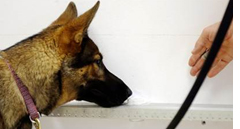
Dogs Sniff Out Prostate Cancer
NBC News: Researchers in Milan, Italy, report that dogs can sniff out prostate cancer with uncanny accuracy.
Urine samples were taken from 320 men with prostate cancer and 357 without it. The cancer ranged from early stage to advanced and metastatic. Both dogs in the study sniffed out prostate cancer in 98 percent of the cases.
This study points out that there are volatile organic compounds in urine that represents a promising approach to cancer detection according to researchers. These findings replicate a smaller study done with a single dog in France who sniffed out prostate cancer in 33 samples.
One important aspect of future research is whether or not different volatile organic compounds are present that can help determine which cancers are slow growing and which are life-threatening.
Dogs have also sniffed out lung tumors and they are being tested to see if they can detect ovarian cancer as well.
spotlight on members
81-year-old Back Playing Team Basketball One Month After Proton Treatment
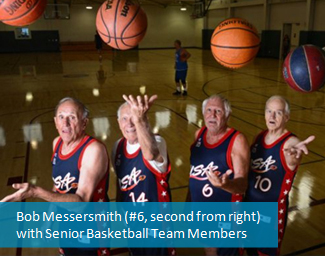
BOB member, Bob Messersmith, 81, of San Juan Capistrano, California, was treated with proton therapy for his prostate cancer at Loma Linda University Medical Center. He wrote to us one month after treatment to tell us that he's back on the court, playing senior basketball. He recently won "The Gold" as California State Champion.
"Encouragement from the 'Balloon Boys' made this all possible," Bob says. Bob also plans to start paragliding in the next few months. He says, "I can do these things because I'm feeling stronger and stronger after proton treatment."
Bob's story also appears on our "Life After Proton" page.
Member Feedback
Maury Astley "Las Vegas, NV" recently celebrated his two-year "proton graduation anniversary."
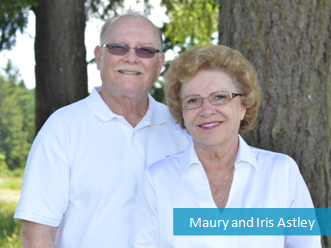
Two years post-treatment, my PSA is down from 6.9 to 0.7. Thanks, Loma Linda!
My proton therapy experience got me back to playing golf, swimming, bowling, and playing Wii Fit. I have lost 20 pounds by eating better and staying active. I also have a part-time consulting job. My wife, Iris, and I have five grandchildren living in California and Oregon. We travel to their activities when we can.
I enjoyed meeting Bob Marckini recently. I have three of his books; one I donated to the local US Too Prostate Cancer Support Group, and the others I loan out to family and friends.
Going Above and Beyond to Promote Proton
Retired USA Army Colonel, Jim Tuggey "Trophy Club, TX", was so thankful for his proton treatment back in 1990, he built a robust website/blog in 2004 to promote proton therapy for prostate cancer. He has been updating his site for 10 years "with regular help from his nephew, Jay Rolls, and guest posts from his brother-in-law, BOB member, Floyd Jordan, treated in 2012).
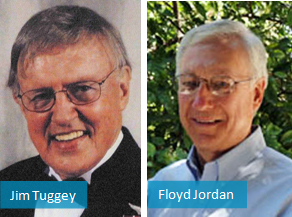
The website continues to do well. Thanks to my nephew, Jay, who orchestrated and designed the entire site. He also regularly contributes posts. Another guest blogger is my brother-in-law and fellow BOB member, Floyd. With their help, as well as information we garner from the BOB, we have received our second accolade as one of "The Best of the Web" blogs by top prostate cancer blog site, Healthline.
Also, I was recently called by the Southlake Texas Methodist Church to inquire if I would attend their weekly cancer meeting. They look at my blog daily and have emphasized their interest in the BOB Tales newsletter. So, thanks, Bob and Deb, for your continuing excellence.
Jim has told us time and time again, "as long as I live, I will do everything I can to spread the word about proton treatment."
New Member Reference List:
Degenerative Muscle Disease
As you know, part of our mission is to spread the word on proton therapy; to have our members share with others their stories and the benefits they received as a result of their treatment decision. One way members reach out is by volunteering to be on one of our former patient reference lists, making themselves available by phone or email to men who are in the treatment research process and seeking information about proton therapy. We currently have 30 reference lists.
In Bob's book, he reported that talking with former patients about how their experiences of proton therapy were a major factor in his treatment decision. He recalls that their stories"of treatment and life after treatment"were in sharp contrast to feedback he received from men who had chosen surgery or conventional radiation.
We are currently looking to produce a new reference list with members who have degenerative muscle disease such as muscular dystrophy. We have recently received a couple of inquiries from prospective patients who would like to speak to former proton patients with any type of degenerative muscle disease. Note that we do not anticipate that you would receive more than one or two emails/calls per year; however we would like to build this list to be prepared for future inquiries. If you have degenerative muscle disease and are willing to email or speak with potential proton patients, please send an email to [email protected]. Thank you.
making a difference by giving back
Funding the Future of Proton: Planned Gifts
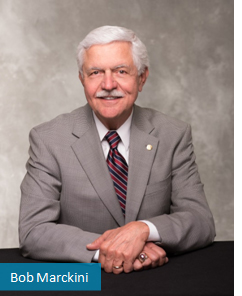
"We would never have had the opportunity to receive proton therapy if others hadn't given before us. I'm directing anything I give, including a bequest in my estate plan, to support the Robert J. Marckini Chair for Proton Therapy Research at Loma Linda University Health."
"Bob Marckini
To learn about naming the James M. Slater, MD, Proton Treatment and Research Center in your will or trust, please contact the Office of Planned Giving at (909) 558-4553 or visit llulegacy.org.
Honoring Her Husband
Through a Gift to LLUMC
We received an email last month from the spouse of one of our members who had recently passed away "not prostate cancer-related". She wrote:
My husband went through proton therapy from September 6 through November 15, 2006. His PSAs remained low until he died on November 16, 2013. He passed away due to congestive heart failure, NOT prostate cancer. Our experience at Loma Linda resulted in a personal relationship with Jesus. I am so grateful for the time spent at LLUMC. My husband's birthday is May 31 and I have tried to think of a special way of honoring him. I've decided to make a contribution to proton therapy research. Thank you so much for all of you at LLUMC.
We at the BOB express our deepest sympathies on this member's passing. We certainly agree that a special way to honor him would be through a contribution to proton therapy research"and we thank his wife for her generosity. Bob Marckini recently returned from Loma Linda after traveling there to attend the Proton Advisory Council meeting. Coincidentally, Dr. Jerry Slater spoke at the council meeting about some of the wonderful research programs underway at Loma Linda, stressing that all the programs would move more quickly with additional funding.
In addition to clinical research efforts that will benefit prostate cancer patients, such as the hypofractionation clinical trials, Dr. Slater spoke of several other basic and clinical research efforts. Three caught Bob's attention: One was using protons to treat arteriovenous malformations "dangerous tangles of arteries and veins in the brain". Another was using the proton beam to treat cardiac arrhythmia, instead of dangerous ablation surgery that carries high risk to the patient. And the one that really caught his attention was a project being led by Dr. James Slater in using the proton beam for treating neurogenic pain resulting from injuries sustained by our service men and women in battle. It appears that the proton beam may be able to stop the excruciating pain that our returning injured military are suffering. All these projects require funding, so any contribution helps.
Bob and his wife, Pauline, contribute every year to proton research and they have also set aside a portion of their estate to go to Loma Linda when they pass on. It's their way of saying "thank you" for all they've been given.
As we've mentioned before, last year Loma Linda honored Bob by establishing the Robert J. Marckini Endowed Chair for Proton Therapy Research. Interest earned from the money raised for the chair will fund research projects at Loma Linda such as those detailed here. The chair is currently funded at $2 million, with a goal of bringing it up to $5 million.
Matching Gift Promises to Double Yours
Don't forget: The founder of the Sequoia Foundation for Achievement in Culture and Education is encouraging fellow BOB members to match a $25,000 challenge grant. The foundation will match gifts of $1,000 or more to the Robert J. Marckini Chair, up to a total of $25,000, until December 31, 2014. Please consider taking this opportunity to double the impact of your gift!
If you are inspired to give or have questions about the various ways to support proton research efforts, please contact the Office of Philanthropy at LLUH at 909-558-3284 or send an email to Aaron Laudenslager at [email protected].
To donate by check, just make it out to "LLUMC Proton," specify Robert J. Marckini Chair in the memo, and mail it to: Loma Linda University Medical Center, Office of Philanthropy, P.O. Box 2000, Loma Linda, CA 92354.
Or, donate online. Specify Robert J. Marckini Chair under "Designations." Both credit and debit cards are accepted.
For more information on how to support the James M. Slater, MD, Proton Treatment and Research Center through an estate gift, contact Todd Mekelburg at the Office of Planned Giving by phone at 909-558-4553, visit the website at llulegacy.org, or email [email protected].
events
BOB Reunion: Near Boise, ID
What: BOB member reunion
When: Sunday, August 3, 2014, 2:00 – 4:00 p.m.
Where: Eagle Seventh-day Adventist Church, 538 State Street, Eagle, ID 83616
LLUH Director of Special Services, Dr. Lynn Martell, will give a VISION 2020 update and report on new proton therapy clinical trials at LLUMC. This is an excellent opportunity to invite recently diagnosed patients and anyone interested in learning more about proton therapy.
Call Jane Hoag at "909" 558-7756 or email [email protected] for more information.
Free Conference: What's New in Targeted Therapy & Imaging for Prostate Cancer?
What: FREE conference for patients, family members, caregivers and advocates
When: Saturday, July 26, 2014, 9:00 a.m. – 4:30 p.m.
Where: Robert H. Lurie Medical Research Bldg., 303 E. Superior, Chicago, IL 60611
The Prostate Cancer Research Institute, Us TOO International, and the Society of Nuclear Medicine and Molecular Imaging have come together to create a free educational event to help you understand how to make good treatment decisions and better understand the disease of prostate cancer.
health
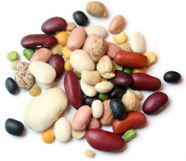
Beans & Blood Pressure
"From the American Journal of Hypertension, 27:56, 2014" Beans, peas, lentils, and other legumes may help lower your blood pressure. Researchers examined eight trials on 554 people who were told to eat either beans "about a cup a day" or other foods with the same calories, typically for about 10 weeks. Systolic blood pressure "the higher number" was lower when the people ate beans instead of other foods. Beans are packed with fiber, protein, potassium, magnesium, folate, iron, and flavor. How can you lose?
Not So Fast
"From the J. Acad. Nutr. Diet, 113: 393, 2014" Eating slowly may help you eat less. Scientists offered 35 normal-weight and 35 overweight or obese men and women a huge portion of the same lunch on two separate occasions. On the fast-eating day, participants were told to eat their lunch as quickly as possible without feeling uncomfortable, to take large bites, chew quickly, and to not pause or put their utensils down between bites. They typically finished eating in nine minutes.
On the slow-eating day, they were told not to rush; take small bites; chew thoroughly; and to pause and put their utensils down between bites. They typically took 22 minutes to eat.
The Results
When slow-eating, they became full before consuming all the food and stopped eating, cutting their calorie intake by 7 to 10 percent. Both groups were less hungry after eating slowly. So, slow down! It takes time for your satiety hormones to kick in.
Chef's Food-Safety Trick
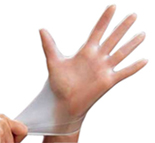
Wear gloves when you cook! You prevent your hands from smelling like onions or garlic … and you protect yourself from illness. Raw foods, especially meats such as chicken and beef, could contain disease-causing bacteria. Even if you wash your hands, these bacteria still can be left behind or settle under your fingernails. Warehouse stores sell inexpensive, disposable food-handling gloves"a box of 1,000 pairs costs about $15.00.
New Series: Top 20 Most Common Health Questions "and Answers"
This month we begin a series on the top 20 most common health questions "and answers" from Business Insider Magazine. Here are the first two:
1. Does Olive Oil Prevent Heart Disease?
Short answer: Yes. The health benefits of olive oil come from the presence of polyphenols, antioxidants that reduce the risk of heart diseases and cancers.
But to get these healthy compounds, consumers should buy good-quality, fresh "extra-virgin" olive oil, which has the highest polyphenol content. Most commercially available olive oils have low levels of polyphenols associated with poor harvesting methods, improper storage, and heavy processing.
2. Do I need sunscreen with more than 30 SPF?
Short answer: No. Sunscreens with an SPF "sun protection factor" of 30 block about 97 percent of ultraviolet rays, while sunscreens with an SPF of higher than 30 block 97 to 98 percent. It's more important that you choose "broad-spectrum" sunscreen, meaning it protects against both UVB and UVA rays.
Sunbathers also need to apply a generous amount of sunscreen in order to get the full benefit of the SPF.
the book
We have 194 reader reviews on Amazon"more than any other book in the top 50! Here is an excerpt from what one reader recently had to say:

Bob Marckini nails it for me in this book! "Richard Beeney
I was diagnosed with prostate cancer in February of this year. I have taken four months to research treatment options. This book finally nailed it for me. It is, by far, the most thorough book on options for prostate cancer patients … I plan to pursue my choice of treatment"proton therapy"because of this book. It is a must-read for any man that is facing a prostate cancer diagnosis. Thanks, Bob, for the time you spent to write this comprehensive book.
We received the following email from a reader:
I've been reading "You Can Beat Prostate Cancer" for the last several days. It was loaned to me by a friend who was just embarking on his adventure with prostate cancer. I wish this book were available to all who are tracking their PSA because it contains a wealth of information under a single cover that laymen can understand. When diagnosed about five months ago, I hit a blank wall and didn't have a clue as to where to start learning about this disease. After being part of a 15-year screening, I should have been more prepared for the bad news, but I was not. Add to this my personal physician's approach and recommendation of watchful waiting, which led me all the way to a 9.3 PSA before I finally acted on it. This book could have a more far-reaching benefit if it were available through local urologists' offices or at least on Amazon. This book is far too important and comprehensive to keep hidden.
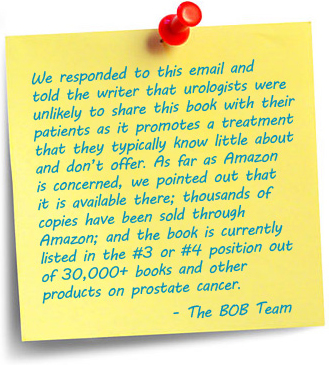
Did you find Bob's book helpful?
Please help us to spread the word and educate others about proton therapy. If you found Bob's book to be helpful in making your proton treatment decision, please post a review on Amazon.
Once you are logged into your Amazon account, click here and click the "Create your own review" button. NOTE: Reviews can be just a few sentences"it only takes a few minutes. And, don't forget to rate the book from 1 to 5 stars!
Don't have an Amazon account? No problem. Sign up here"it's free.
Available in Amazon's Kindle format, Barnes & Noble's NOOK Book, and Apple iBook format
Buy the Kindle version now for $9.99.
Don't have a Kindle? No problem"just download the free Kindle reading software for your smart phone or tablet.
Buy the NOOK Book version now for $9.99.
Don’t have a NOOK? No problem. Just download the free NOOK reading app for your Android smart phone, tablet, or iDevice.
Buy the book from the iTunes store for $9.99 for your iPhone, iPad, or iPod Touch in iBook format.
The hard copy version of You Can Beat Prostate Cancer is available online at Amazon, Barnes & Noble and LuLu Press.
Proceeds from book sales are used to help fund BOB efforts and to support proton therapy research.
Ask about our bulk discount for hard copy books for anyone interested in spreading the word about proton therapy: [email protected]
odds & ends
Hidden Miracles of the Natural World
TED Talks is a series of videos featuring the world's leading thinkers and doers, sharing their work in 18 minutes or less. We find many of these videos fascinating. A recent Ted Talks video caught our attention. It is titled, Hidden Miracles of the Natural World. It runs a little over seven minutes and it's worth watching.
We live in a world of unseeable beauty, so subtle and delicate that it is imperceptible to the human eye. To bring this invisible world to light, filmmaker Louie Schwartzberg bends the boundaries of time and space with high-speed cameras, time lapses, and microscopes. We are on the threshold of some extraordinary advances.
Owning a Car Costs an Average of $9,150 a Year
This is for an ordinary midsize car, such as a Toyota Camry or Ford Fusion. The cost, $760 per month, covers fuel, maintenance, tires, insurance, license, registration, depreciation, and finance charges. It is based on driving 15,000 miles a year, starting with a new car, and driving it for five years. The same factors make the cost of an SUV higher"$11,600 per year, or $967 per month. Luxury and sports cars can cost substantially more.
To Reduce Costs
Bottom Line/Personal magazine recommends that you buy only as large and costly a car as you need. Always buy used"depreciation is the biggest car expense, with an average 20 percent value loss in the first year.
What Happens When You Leave a Fortune … To No One?
Roman Blum was always somewhat of a mysterious man. No one was sure where exactly in Poland the Holocaust survivor and New York real estate developer was from, nor what his true birth date was. Some friends claim that he had a wife and child who died in the Holocaust, but there is no record of them.
When Blum died in 2012, at age 97, the mystery lived on. Although his estate was valued at nearly $40 million, Blum died without a will. That makes his the largest unclaimed estate in New York history.
Blum, whose ex-wife died in 1992, and who had no children, left behind no heirs. The state public administrator assigned to the case has already sold more than $5 million worth of Blum's personal property and auctioned off personal items. He is also using Blum's estate to fund a genealogist to search for relatives. So far, they have yet to find an heir.
However, the state has received hundreds of emails from all over the world"people claiming to be relatives of Blum. In addition, two people have come forward alleging they have valid wills. One is an upstate New York attorney who claims his great-grandfather had a connection to Blum. The other is a 90-something-year-old Polish woman who says she is the beneficiary and a childhood acquaintance of Blum's.
If the court finds neither of these claims valid, and never finds an heir, everything from Blum's estate will pass to the state.
Learn From Roman Blum's Mistake
No matter the size of your estate, you should make sure you have a plan in place so that your assets, real estate, heirlooms, and other property go to the people and organizations you care about"not the government.
Special Series: Messing with Your Mind
Here's the third in a series of five optical illusions that really mess with your mind.
How many"3 or 4?
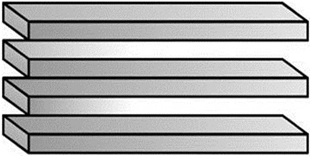
Did You Know?
- The Netherlands is closing 19 prisons due to a serious prisoner shortage.
- Sweden is so good at recycling; it has run out of garbage and now must import garbage from Norway to fuel its energy programs.
- Brass doorknobs automatically disinfect themselves in about eight hours.
- After needing 13 liters of blood for a surgery at the age of 13, a man named James Harrison pledged to donate blood once he turned 18. It was discovered that his blood contained a rare antigen that cured Rhesus disease. He has donated blood a record 1,000 times and saved 2 million lives.
on the lighter side
Last Month's Brain Teaser: An Easy One
What can run, but never walks? What has a mouth, but never talks? What has a head, but never weeps? What has a bed, but never sleeps?
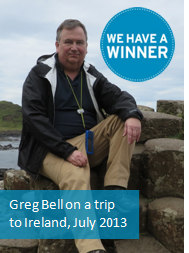
Answer: A river. Perhaps this one was too easy. Deb received hundreds of responses to last month's brain teaser"they filled her inbox for days! Although responses came in by the dozen within minutes of issuing the newsletter "do readers receive the newsletter and immediately scroll down to the brain teaser?", Greg Bell of Salem, New Jersey, was the first to submit the correct answer.
Greg is a brand new BOB member who will start his proton treatment this week. "My urologist wanted to operate on me and was miffed when I mentioned proton," Greg told us. "I spoke with over 15 men about their proton experiences, including a number of BOB members, before making my decision. Everyone was very helpful." He also mentioned that Bob's book was helpful in making his treatment choice.
Congratulations, Greg"your signed book is on the way!
New Brain Teaser/Riddle
Pronounced as one letter, and written with three, Two letters there are, and two only in me. I'm double, I'm single, and I'm black, blue and gray. I'm read from both ends and the same either way.
What am I?
Answer next month: The first to send an email to [email protected] with the correct answer will receive a signed copy of Bob's book. No cheating by using the Internet!
Why Seniors Still Need Newspapers
I was visiting my daughter last night when I asked if I could borrow a newspaper. She responded, "This is the 21st century. We don't waste money on newspapers. Here, use my iPad."
I can tell you this: That fly never knew what hit him.
What Did You Teach?
My name is Alice, and I was sitting in the waiting room for my first appointment with a new dentist. I noticed his DDS diploma on the wall, which bore his full name. I suddenly remembered a tall, handsome, dark-haired boy with the same name had been in my high school class some 40-odd years ago. Could he be the same guy that I had a secret crush on back then?
Upon seeing him, however, I quickly discarded any such thought. This balding, gray-haired man with the deeply lined face was way too old to have been my classmate.
After he examined my teeth, I asked him if he had attended Morgan Park High School. "Yes. Yes. I did. I'm a Mustang," he gleamed with pride.
"When did you graduate?" I asked.
He answered, "In 1967. Why do you ask?"
"You were in my class," I exclaimed.
He looked at me closely. Then that ugly, old, bald, wrinkled-faced, gray-haired, decrepit jerk said, "What did you teach?"
Quote of the Month
"Don't pray when it rains if you don't pray when the sun shines."
"Satchel Paige
final thought
The Seven Wonders of the World
A group of students were asked to list what they thought were the current "Seven Wonders of the World." Though there was some disagreement, the following received the most votes:
- Egypt's Great Pyramids
- Taj Mahal
- Grand Canyon
- Panama Canal
- Empire State Building
- St. Peter's Basilica
- China's Great Wall
While gathering the votes, the teacher noted that one quiet student hadn't turned in her paper yet. So she asked the student if she was having trouble with her list. The girl replied, "Yes, a little. I couldn't quite make up my mind because there are so many."
The teacher said, "Well, tell us what you have, and maybe we can help."
The girl hesitated, then read, "I think the Seven Wonders of the World are:
- To touch
- To taste
- To see
- To hear
- To feel
- To laugh
- To love
The room was so quiet; you could have heard a pin drop. The things we overlook as simple and ordinary and that we take for granted are truly wondrous!
A gentle reminder: The most precious things in life cannot be built by hand or bought by man.
Low PSAs to all,
Bob Marckini and Deb Hickey
You can download this month's BOB Tales in PDF format to your computer by "right-clicking" ("control-clicking" on Mac) and going to the "Save Target As… " option on the menu that pops up.
NO MEDICAL ADVICE: Material appearing here represents opinions offered by non-medically-trained laypersons. Comments shown here should NEVER be interpreted as specific medical advice and must be used only as background information when consulting with a qualified medical professional.

